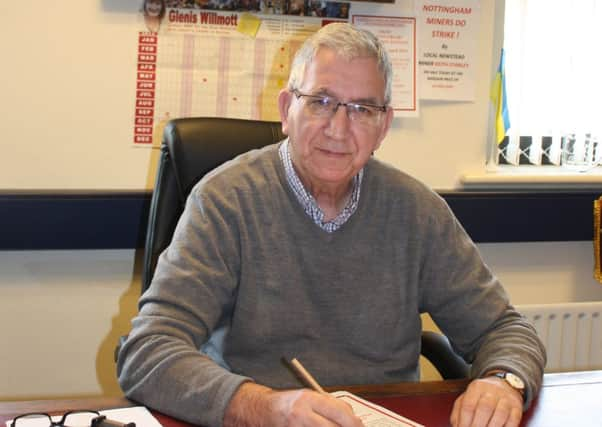Eric Eaton, chairman NUM Ex and Retired Miners’Association guest column


Margaret Thatcher the Prime Minister during the year long strike always maintained that the dispute was between the National Coal Board and the National Union of Mineworkers and the Government had no input save to condemn the violence on the picket line.
We now learn from the released cabinet papers, that far from not being involved, Thatcher had organised a small committee to oversee the strike and was very much involved in overseeing the day to day planning of the Governments response to the strike.
Advertisement
Hide AdAdvertisement
Hide AdSo here we have a Prime Minister of Great Britain actually lying to the British people.
She was not the only one, in June of 1984 Ian Macgregor the then Chairman of the National Coal Board sent a letter to all striking miners which states and I quote:-This is a strike which should never have happened.
It is based on a very serious misrepresentation and distortion of the facts.
At great financial cost miners have supported the strike for fourteen weeks because your leaders have told you this...... That the Coal Board is out to butcher the coal industry. That we plan to do away with 70,000 jobs.
Advertisement
Hide AdAdvertisement
Hide AdThat we plan to close down 86 pits, leaving only 100 working collieries. IF THESE THINGS WERE TRUE I WOULD NOT BLAME MINERS FOR GETTING ANGRY OR FOR BEING DEEPLY WORRIED. BUT THESE THINGS ARE ABSOLUTELY UNTRUE. I STATE THAT CATEGORICALLY AND SOLEMNLY. YOU HAVE BEEN DELIBERATELY MISLED.
Yes we were misled but not by the Union but by Ian Macgregor himself because it now transpires from the release of the Cabinet papers that he and the Tory Government in 1983 already had in place plans to close 75 pits with the loss of 75,000 jobs, when they were telling the British people that they had plans to only close 20 with a loss of 20,000 jobs. These Cabinet papers prove who was telling lies and who was telling the truth.
Arthur Scargill the President of the National Union of Mineworkers at the time of the strike was under constant attack from the Government, Coal Board and most of the British media. In the event it was only Scargill who was proved to be telling the truth. He was saying that the Coal Board had plans to close 70 pits with the loss of 70,000 jobs; well we now know he actually underestimated the number because Macgregor had plans in place to close 75 pits with a loss of 75,000 jobs.
As for Scargill getting all the blame this was obviously a ploy by the Government and Coal Board and in some respect by most of the media, to aim all their fire at just one figure head in the Union and blame that one person for the strike to try to turn people against the striking miners. I would just like to dispel some of the myths and misrepresentations that might exist in people’s minds about how democracy works within the NUM.
Advertisement
Hide AdAdvertisement
Hide AdOne of those myths was that the Union was at the time of the strike run by Arthur Scargill. This was not the case. The NUM was, and is, run on a structural basis: this means Areas of the Union elect National Executive Committee members to represent them at National level and these members have a vote at the NEC meetings. It’s called representative democracy, the very same as elections for our own Parliament, European Parliament, County Council elections, District Council elections and Parish Council elections. All these are representative democracies. The President and General Secretary of the NUM (in1984/85 Arthur Scargill and Peter Heathfield respectively) do not have a vote at the NEC meetings.
The supreme body of the NUM is the Annual Conference to which Delegates from the whole country attend and at which again the President and General Secretary don’t have a vote. They are charged with carrying out the wishes of the elected delegates and NEC members.
In June of 1984 a Special Conference of the NUM was called and on the agenda was a motion to ballot members on a national strike, the motion was defeated but a few Areas could not accept the democratic decision of the Union even though they had taken part in the democratic processes of the Union and had never previously challenged the rules which covered this process. So why did they leave the conference, still insisting on a ballot? Did they have other hidden agendas other than trying to save their members jobs, pits and communities? The Notts Area NUM and the South Derbyshire Area NUM broke away from the National NUM in 1985 and formed the UDM, I will leave you to make up your own mind. The Notts NUM reformed after the breakaway and are still representing members today.
After March 1985 the pit closure programme was started again with a vengeance. The Tory Government had promised the Notts miners that if they carried on working through the Great Strike their pits would be safe. More lies. By 2013 all that Nottinghamshire had left was one colliery producing coal and one mothballed awaiting investment. The Notts Area coal mining industry is now completely decimated. The country now imports 40, 50, 60 million tons of coal from abroad per year to keep the lights. This is the economics of the mad house, closing all our own pits and employing miners abroad whilst our own miners are thrown on the dole.
Advertisement
Hide AdAdvertisement
Hide AdOn the 12th April 2014 at the Festival Hall Kirkby-in-Ashfield the NUM Notts Area are holding a thirtieth Anniversary Celebration Evening of the strike. Tickets available from the Notts NUM on 01623 621611.